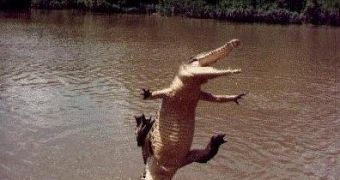Steve Irwin made famous through his crocodile wrestling the spectacular spin with its devastating results of these reptiles.
Now a team made of a biologist and physicist, based on high-speed video recordings of young alligators spinning realized a scientific approach to this behavior.
This way, they created a first mathematical model explaining how these reptiles can spin with such force in the water.
West Chester University biologist Frank Fish and physicist Anthony Nicastro and colleagues Sandra Bostic and John Beneski investigated the spinning of juvenile alligators in water after biting into a pliable target.
The team examined the specific mechanics of the spinning movement, detailed on body components.
"The death roll is a behavioral strategy referred to as 'rotational feeding,'" explains Fish, whose team also investigated the mechanic and energetic performance of spinning dolphins.
"Spinning motions are seen in birds, sea lions and humpback whales as well, but these animals use their wings or wing-like flippers to actually roll or bank," said Fish.
But alligators and crocodiles tuck in their legs and, in just a few milliseconds, displace their Tails to the side, which shifts the moment of inertia, permitting the crocodilian to begin its spinning in a way similar to that figure of skaters' sped up spinning motion.
"The alligator centralizes its mass and axis of rotation by keeping its legs close to its body. This also effectively reduces drag and enables it to create a faster, more powerful spin. Similarly, human divers create a central axis as they somersault from a diving board." said Fish.
The team also found that alligators could not make the move when their tails were restrained, even when they got a grip onto their prey.
Without the death roll, crocodilians could not dismember large prey as their conical, spike-like teeth can only crash the victim.
"These animals don't chew their prey. So, when they capture a prey that's exceptionally big, they go into the death roll in order to break it apart." said Fish.
This research, contrary to earlier beliefs, revealed that this behavior is innate, not learned, nor limited to large individuals.
"The young alligators we have in the lab were collected very early or as eggs, so they did not learn about the death roll from older alligators. When we gave them meat and tugged on it, they started producing the death roll immediately on their own." added Fish.

 14 DAY TRIAL //
14 DAY TRIAL //